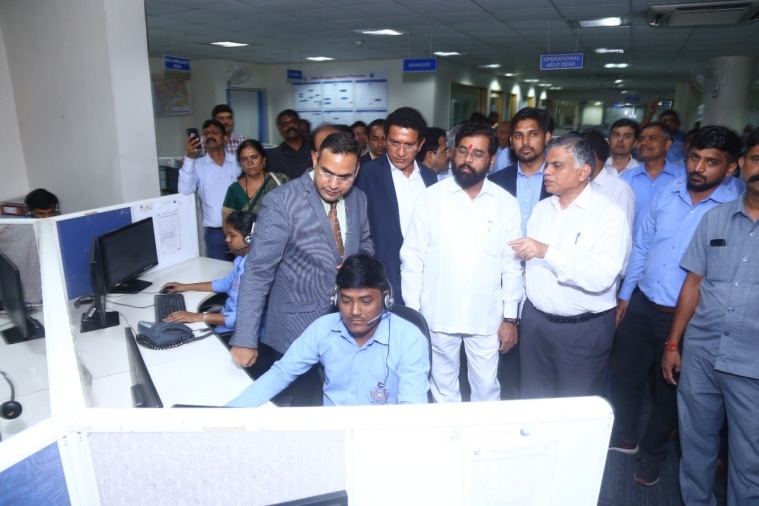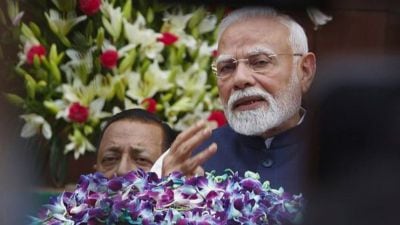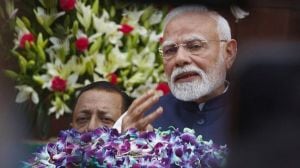Click here to join Express Pune WhatsApp channel and get a curated list of our stories
Nine years since inception, Maharashtra’s Dial 108 ambulance service has assisted over 81 lakh patients
The aim of the project – set up by the National Health Mission, Government of Maharashtra, and operated by BVG India Ltd – has been to reduce mortality and morbidity by providing prehospital care through ambulances during medical emergencies.
 A picture of CM Eknath Shinde visiting emergency response centre at Pune. (Express Photo)
A picture of CM Eknath Shinde visiting emergency response centre at Pune. (Express Photo) More than 81 lakh patients have so far availed the services of the Maharashtra Emergency Medical Services, commonly known as the Dial 108 project, launched on January 26, 2014, authorities said. Nine years since the initiative was set up, the Dial 108 project has also proved to be life-saving for 4.8 lakh victims of road accidents.
The aim of the project – set up by the National Health Mission, Government of Maharashtra, and operated by BVG India Ltd – has been to reduce mortality and morbidity by providing prehospital care through ambulances during medical emergencies. This service is free of cost and includes a fleet of 937 ambulances with a centralised call centre in Pune.
The toll-free number 108 is accessible from across Maharashtra. The Pune-based centralised control room takes down necessary information, including the name, address and medical information regarding the patient from the caller, and dispatches the nearest 108 ambulance to the concerned patient.
 Maharashtra CM Eknath Shinde at the emergency response centre at Pune. (Express Photo)
Maharashtra CM Eknath Shinde at the emergency response centre at Pune. (Express Photo)
Dr Dnyaneshwar Shelke, chief operating officer of BVG Maharashtra Emergency Medical Services told The Indian Express that over a period of nine years, the 108 ambulances have attended to more than 47 lakh medical cases , 14.55 lakh pregnant women, 71,840 assault cases, 25,912 victims of burn injuries, 39,738 cardiac cases. The ambulance service also reached out to more than 1.5 lakh persons who suffered injuries due to a fall and almost two lakh victims of poisoning.
The Pune-based centralised control room, also known as the Emergency Response Centre, is a modern medical call centre for gathering information from callers throughout Maharashtra and dispatching ambulances to needy patients. The Emergency Response Centre is operational 24×7 and has more than 200 trained personnel.
Dr Shelke pointed out that the response centre has all modern technologies for effective and accurate dispatches, including CAD system, Integration of GPS and GIS system, voice logger systems, Data Management Systems and has also integrated new technology like “Whats 3 Words” in the control room for effective address capturing of patients who are unable to communicate their exact address.
On any day the control room gets almost 7,500 calls. The Emergency Response Centre has been integrated with police and fire control rooms across the state. It has also integrated mobile applications of doctors and drivers in ambulances for case closures and sharing live dispatch information with field staff. Real-time dashboard is accessible for stakeholders too, Dr Shelke said.
Doctors have to go through 18 days of training with Symbiosis before joining, followed by regular refresher courses. Currently, MEMS has over 3,200 doctors and 2,600 drivers on ambulances.
“Recently, we added a fleet for Balasaheb Thackeray Samruddhi Highway Emergency Response to serve highway emergencies. Besides four-wheeler ambulances, we also operate 30 bike ambulances in Mumbai, Thane, Gadchiroli and Melghat in Amravati. These bike ambulances serve as first responder vehicles and are convenient to use in locations where a four-wheeler ambulance cannot be sent. In deep tribal blocks, these ambulances can reach in less time,” Dr Shelke added.
Click here to join Express Pune WhatsApp channel and get a curated list of our stories













